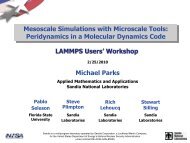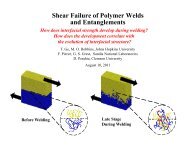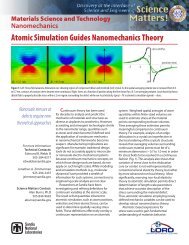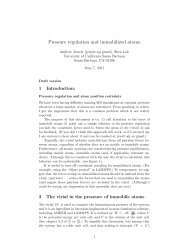Studies of the Molecular Weight Dependence of the Glass ... - Lammps
Studies of the Molecular Weight Dependence of the Glass ... - Lammps
Studies of the Molecular Weight Dependence of the Glass ... - Lammps
You also want an ePaper? Increase the reach of your titles
YUMPU automatically turns print PDFs into web optimized ePapers that Google loves.
<strong>Studies</strong> <strong>of</strong> <strong>the</strong> <strong>Molecular</strong> <strong>Weight</strong><br />
<strong>Dependence</strong> <strong>of</strong> <strong>the</strong> <strong>Glass</strong> Transition<br />
Temperature <strong>of</strong> Oligomers<br />
M. Halls, P. Saxe and D. Rigby<br />
Materials Design, Inc.<br />
Angel Fire, NM and San Diego, CA<br />
LAMMPS Users' Workshop<br />
Albuquerque NM, August 10, 2011<br />
1
Background<br />
●<br />
●<br />
●<br />
●<br />
●<br />
History<br />
●<br />
First MD studies <strong>of</strong> glass formation for simple LJ systems:<br />
●<br />
Clarke – J. Chem. Soc. Faraday II 75, 1371 (1979)<br />
●<br />
Andersen et al – J. Phys. Chem. 88, 4019 (1984)<br />
●<br />
Analogous studies on united atom flexible chain molecules:<br />
●<br />
Roe et al – J. Chem. Phys. 87, 7285 (1987)<br />
Most commonly applied approach to locate Tg is based on identifying<br />
location <strong>of</strong> discontinuity <strong>of</strong> slope in volume-temperature curves, at<br />
constant P (i.e. analogous to dilatometry studies)<br />
Quantitative comparison with experimental Tg not attempted in earliest<br />
studies. Later studies <strong>of</strong> a variety <strong>of</strong> systems initially reported Tg higher<br />
than experiment, e.g.<br />
●<br />
Boyd et al – Macromolecules 27, 7781 (1994)<br />
Explained by effective cooling rates in simulations orders <strong>of</strong> magnitude<br />
faster than experiments (i.e. simulations are essentially measuring an<br />
ultra high frequency Tg for which Tg > Tg(1Hz) )<br />
Some published results report almost exact agreement with experiment,<br />
(even with force fields known to give poor prediction <strong>of</strong> PVT behavior)<br />
2
Typical V-T Curves - OTP<br />
Ortho-Terphenyl is experimentally one <strong>of</strong> <strong>the</strong> most widely studied model<br />
glass forming systems. Typical simulation results with a good force field<br />
(COMPASS) give Tg ~73 degrees higher than experiment:<br />
3
Typical V-T Curves - Glycerol<br />
With glycerol, more extensive curvature is observed at high<br />
temperatures. However, <strong>the</strong> Tg can be estimated to be not less than<br />
287.6K, at least 90 deg higher than experiment<br />
4
Some Tg Simulation Issues<br />
●<br />
Factors that can potentially affect apparent Tg determined from<br />
simulations:<br />
●<br />
Methodology: V-T curves from simulations <strong>of</strong>ten do not show welldefined<br />
linear low and high temperature regions<br />
●<br />
Cooling rate effects can be evident<br />
●<br />
Force field absolute accuracy needs to be high<br />
●<br />
O<strong>the</strong>r issues arise, especially for chain molecule systems:<br />
●<br />
Variations in molecular architecture, such as stereoregularity/tacticity,<br />
repeat unit orientation, isomer composition (as in vinyl content <strong>of</strong><br />
dienes etc) can in principle sometimes affect <strong>the</strong> actual Tg<br />
●<br />
Slow volume relaxation on <strong>the</strong> simulation time scale can shift and<br />
distort simulation curves<br />
●<br />
Commercial polymers are <strong>of</strong>ten polydisperse<br />
●<br />
A deeper understanding <strong>of</strong> simulations (leading to routine and accurate<br />
Tg prediction) requires fur<strong>the</strong>r, ideally systematic, studies...<br />
5
Opportunities for Systematic <strong>Studies</strong><br />
●<br />
●<br />
Tg <strong>of</strong> oligomers <strong>of</strong> a given polymer are known in some cases to vary<br />
widely, spanning a range <strong>of</strong> as much as 200 degrees before reaching <strong>the</strong><br />
high molecular weight limit characteristic <strong>of</strong> <strong>the</strong> polymer <strong>of</strong> interest<br />
Although extensive experimental data sets exist for only a few polymers,<br />
fortunately good data exist for some <strong>of</strong> <strong>the</strong> simpler systems, such as<br />
polystyrene and poly(α-methyl styrene), e.g. from Cowie & Toporowski,<br />
Eur. Polym. J. 4, 621 (1968):<br />
●<br />
From a simulation perspective:<br />
●<br />
Some good force fields are available for predicting EOS behavior<br />
●<br />
Experimentally, tacticity effects are known to be minor<br />
6
Tg <strong>Studies</strong> – This Work<br />
●<br />
Study poly(α-methyl styrene) with degree <strong>of</strong> polymerization (DP) = 1, 2,<br />
3, 4, 5, 6, 9, 15, 20, 80. <strong>Molecular</strong> weight = 118, 236, 354, 472, 590,<br />
708, 1062, 1770, 2360, 9440<br />
●<br />
Perform stepwise cooling NPT simulations using LAMMPS:<br />
●<br />
25 degree intervals from typically 623K to 23K<br />
●<br />
Use 100ps, 500ps, 2500ps NPT simulation at each temperature<br />
●<br />
Study both isotactic and atactic chains<br />
●<br />
Use refined version <strong>of</strong> pcff force field from LAMMPS distribution<br />
7
Results – Rate Effects DP=1<br />
●<br />
Poly(α-methyl styrene) with DP=1 (isopropyl benzene) shows little<br />
evidence <strong>of</strong> cooling rate effects on V-T curves:<br />
8
Results – Rate Effects DP=4<br />
●<br />
Some cooling rate effects become evident for poly(α-methyl styrene) with<br />
DP>4<br />
9
Results – Relaxation Effects<br />
●<br />
Relaxation effects eventually become apparent on repeating stepwise<br />
cooling cycles multiple times, e.g. for DP=20:<br />
10
Results – Tacticity Effects<br />
●<br />
Relaxation effects make comparisons difficult, but tacticity effects may be<br />
minor (?), e.g. at DP=80:<br />
11
Results – Anomalies<br />
●<br />
Working with a crystallizable polymer can sometimes lead to unusual<br />
behavior, e.g. isotactic poly(α-methyl styrene), for which Tm = 441K,<br />
showed <strong>the</strong> following:<br />
12
Results – All Oligomers<br />
●<br />
Comparison <strong>of</strong> V-T curves for poly(α-methyl styrene) oligimers with<br />
DP=1-80. All samples are isotactic, and cooling rates <strong>of</strong> 500ps per 25K<br />
interval are used. The plot on <strong>the</strong> right shows <strong>the</strong> experimental data <strong>of</strong><br />
Cowie at al for chain lengths up to DP=90:<br />
13
Summary & Ongoing Work<br />
●<br />
Calculations on low molar mass model compounds relevant to<br />
polystyrenes show excellent agreement with experimental PVT behavior<br />
●<br />
Differences in <strong>the</strong>rmal expansion behavior, and its systematic shifting to<br />
higher temperatures as chain length increases is visible, but:<br />
●<br />
Precise identification <strong>of</strong> high and low temperature regions remains<br />
difficult<br />
●<br />
Cooling rate effects and slow relaxation <strong>of</strong> <strong>the</strong> system have <strong>the</strong><br />
potential to distort <strong>the</strong> results<br />
• Need to investigate 'smoothing out' <strong>of</strong> high temperature melt data for<br />
longer chains by simulating , e.g., 10x larger systems<br />
• Investigation <strong>of</strong> curve fitting to determine transition between low and high<br />
temperature behaviors for comparison with experimental Tg<br />
• Parallel series <strong>of</strong> calculations with polystyrene underway<br />
• Possible extension to o<strong>the</strong>r systems such as polybutadienes<br />
• Summary planned at 2011 AIChE Annual Meeting in Minneapolis<br />
14
















